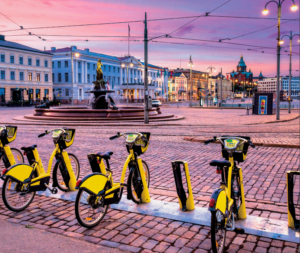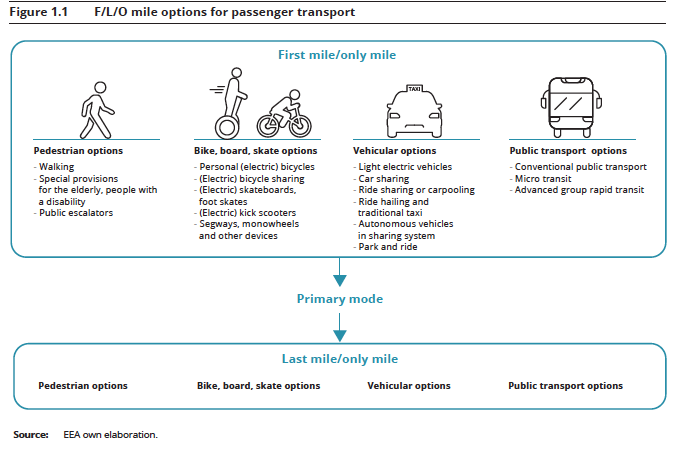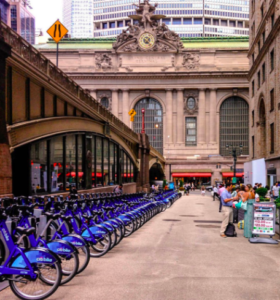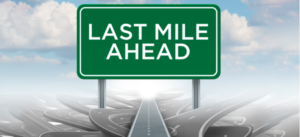The European Environment Agency recently published a report on The first and last mile — the key to sustainable urban transport to assess the viability of transport options for short distance travel in cities, as well as ways of making urban freight transport more sustainable. About 50% of the world’s population now live in urban areas, and 75% are expected by 2050. Moreover, transport emissions are still on the rise, and account for about one quarter of Europe’s greenhouse gases (GHGs). Transport also continues to be a significant source of air pollution, with serious health impacts.
There are also economic and quality of life issues associated with the length of one’s travel to and from work. For instance, Dubliners use public transportation less than many EU cities. Figure 2.2 at 16. That may account for the fact that Dublin is second only to Rome in the number of hours lost in traffic congestion. At 27.
So what is and what is not sustainable for short distance travel in cities is critical.

The Report
Most people in cities travel from home to work, and back, by bus, rail and metro services as the main mode of transport. But everybody has to get from home to that main mode, e.g., bus stop or train or metro station, and then from the main mode stop or station to a work place. The former is classified as the “first mile” and the latter is the “final mile.” The report also includes “only mile” transport, when one travels from home to work with only one mode, e.g., driving, walking the entire way, or using a cab, Uber or Lyfte or comparable means.
In the past people would often walk for the first and last mile, or use one form of public transport, e.g., a bus, to reach another mode of public transport, e.g., subway or train. There were always limits to the options for first and last mile, as it is a commonly cited rule that most people will walk about 400m or 1/4 mile to get to public transport, though many will walk twice that distance if the public transport is fast rail rather than slow bus. Also, Europeans tends to be comfortable with slightly longer distances.
But things they are a changing with a number of new options for the first and last mile, and for freight delivery over the last mile. These options are the focus of the EEA report.
Options
More sustainable first and last mile options can reduce car usage, thereby lowering traffic congestion, emissions and improving air quality. There are a number of emerging options but whether they are sustainable is not an easy question. It depends on how the option is used and what it replaces.
For instance, if a shared e-scooter replaces a motorcycle or car, good. If it replaces a trip by foot or bike, not so good as e-scooters require more resources to make than walking boots or bikes, and higher maintenance, including frequent collection for re-charging.

First and last mile options include public escalators and special provisions for the elderly and people with a disability for walking in the city; personal (electric) bicycles, with sharing, electric skateboards, foot skates and scooters, and segways and monowheels; light electric vehicles, car sharing, ride sharing or carpooling, ride hailing and traditional taxi, autonomous vehicles, park and ride; and conventional public transport, micro transit, and advanced group rapid transit.
The report examines many of the newer options, as well as the traditional first/last mile modes. We will just point out a few that are evaluated by the EEA.
Vehicle sharing or schemes for cars, such as Uber and Lyft, might be convenient, but they are not necessarily sustainable. The report concludes that they do little to reduce emissions or congestion, and actually draw people away from public transport as studies show that a majority of ride-hailing trips replace a public transport trip.
Coming soon may be autonomous vehicles but putting more cars on the roads, even without drivers, is not necessarily helpful.
The report also argues that the external costs of cars for the harm they do to health and the environment need to be added when comparing options for first and last mile.
While the emerging options for first and last mile transport offer some advantages, the report stresses that public transport remains the foundation for sustainable urban transport. And the first and last mile options need to feed public transport and to make it more efficient, flexible and attractive.
Helping to sustain public transport are the old stand-bys, walking and biking. Walking continues to offer the greatest societal benefits, including physical exercise and more sustainable urban mobility. And walking can be enhanced by making it easier to walk everywhere, avoiding barriers, and making urban spaces more pleasant and attractive (trees and plantings help). Cycling needs to be supported and has become the dominate mode of transport to/from work in various European cities.

Clearly urban planning can help support public transport by encouraging a shift to transit-oriented development, e.g., developing housing near public transport.
Freight Transport
Freight transport also has last mile challenges. Goods are delivered to consolidation centers typically on the periphery of cities from a regional distribution center, or factory. From the consolidation center goods are delivered to their final destination in the city — the last mile — in smaller, less polluting vehicles. The last mile in delivering goods represents a substantial portion of the costs for transporting goods.

To reduce the last mile costs, and make freight more sustainable, there are plans to create micro-hubs (like mini consolidation centers) throughout the city. From these micro-hubs the goods can be taken on their last mile by cargo bikes or picked up by the consumer.
Conclusions
The goal of a sustainable public transport network is a seamless, fast and comfortable system that minimizes delays, waiting time, and transfers. Efficient, sustainable first and last mile modes can support and enhance that system and they can survive economically if the external costs of cars are added to any cost and benefit analysis.
Sources:
European Environment Agency, The first and last mile — the key to sustainable urban transport. Transport and environment report 2019 (2020). bit.ly/33PUSFa
Jarrett Walker, “How far will people walk for public transport – and how close should stops be?” City Metric (3 July 2015). bit.ly/3dwC3vb


No comments yet, add your own below